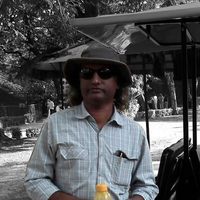Chelmala Srinivasulu
Osmania University, Zoology, Faculty Member
- Herpetology, Ornithology, Phylogenetics, Wildlife Conservation, Environment, Ornithology, Chiroptera, herpetofauna, Zoology, and 15 moreConservation Biology, Biodiversity, Conservation, Mammalogy, Marine Mammals, Bats (Mammalogy), Birds, Birds (Ecology), Chiroptera, Spiders, Birds of prey, Tiger ecology, Diversity, Southeast Asia, and Biodiversity Conservationedit
Research Interests:
Research Interests:
Research Interests:
Summary and enumeration of the Biodiversity of Greater Hyderabad
We provide the echolocation call characteristics of two endemic Hipposiderid bats, the Kolar Leaf-nosed Bat Hipposideros hypophyllus and Durga Das’s Leaf-nosed Bat H. durgadasi from Kolar district, Karnataka, India for the first time.... more
We provide the echolocation call characteristics of two endemic Hipposiderid bats, the Kolar Leaf-nosed Bat Hipposideros hypophyllus and Durga Das’s Leaf-nosed Bat H. durgadasi from Kolar district, Karnataka, India for the first time. The calls consisted of a constant frequency (CF) component followed by a frequency modulated (FM) tail. It was found that, on comparison with the call frequencies of other members of the bicolor group of the genus Hipposideros previously reported from different parts of southeast Asia, H. durgadasi, though larger than H. cineraceus, called at a much higher frequency (168.4 – 175.7 kHz). H. hypophyllus, on the other hand, called between 103.0 – 106.4 kHz. In this paper we present our findings and analysis of the calls of these endemic species.
Research Interests:
Morphometrics and phylogenetic analysis based on 12S and 16S ribosomal RNA (rRNA) gene sequences reveal that Riopa ashwamedhi Sharma, 1969 is placed incorrectly in the genus Riopa or Lygosoma, and we transfer this taxon to the genus... more
Morphometrics and phylogenetic analysis based on 12S and 16S ribosomal RNA (rRNA) gene sequences reveal that Riopa ashwamedhi Sharma, 1969 is placed incorrectly in the genus Riopa or Lygosoma, and we transfer this taxon to the genus Eutropis. New material of this rare and endemic species forms the basis of the generic reassignment. A detailed description of E. ashwamedhi (Sharma, 1969) comb. nov. and natural history notes are provided based on the new material collected in Andhra Pradesh, India.
Research Interests:
Galeodes indicus (Pocock, 1900), the solifugid has been earlier reported from Nallamalla hills in Andhra Pradesh(united Andhra Pradesh) but was hitherto unknown from Telangana state, India. In this paper we give the first report of the... more
Galeodes indicus (Pocock, 1900), the solifugid has been earlier reported from Nallamalla hills in Andhra Pradesh(united Andhra Pradesh) but was hitherto unknown from Telangana state, India. In this paper we give the first report of the sun spider with notes on the external characters and morphometry of the specimen.
Research Interests:
The nominate subspecies of the lesser woolly horseshoe bat
Research Interests:
Research Interests:
Research Interests:
The checklist includes enumeration of all the living and recently extinct species known to occur or have occurred in South Asia. Taxonomic arrangement is following Wilson and Reeder (2005) and comments are added at appropriate places... more
The checklist includes enumeration of all the living and recently extinct species known to occur or have occurred in South Asia. Taxonomic arrangement is following Wilson and Reeder (2005) and comments are added at appropriate places where deviations were incorporated following works published after 2005. Necessary taxonomic comments have been provided at order, family, genus, and species levels. Wherever necessary, additional classification levels have been included. The checklist is based on the best of our ...
The mammalian diversity found in South Asia (Fig. 2.1) includes 506 species in 215 genera in 14 orders which represents approximately 9.3% of the world's mammalian diversity (Table 2.1). The genetic diversity accounts... more
The mammalian diversity found in South Asia (Fig. 2.1) includes 506 species in 215 genera in 14 orders which represents approximately 9.3% of the world's mammalian diversity (Table 2.1). The genetic diversity accounts for 19% of the world's diversity. The complete list of mammals of South Asia with their common names is given in Table 2.2.
Research Interests:
Research Interests:
Whip-‐spiders(Amblypygi) from Indian subcondnent are represented by a few species that were described by Po-‐cock (1900). Recently Weygoldt(1996) has revised and updated the Amblypygid fauna from Asia and Africa under the family... more
Whip-‐spiders(Amblypygi) from Indian subcondnent are represented by a few species that were described by Po-‐cock (1900). Recently Weygoldt(1996) has revised and updated the Amblypygid fauna from Asia and Africa under the family Phrynichidae. In India, the genus Phrynichus is represented by only two species that is, Phrynichus phip-‐soni Pocock, 1900 and Phrynichus andhraensis Bastawade et al., 2005. Phrynichus phipsoni Pocock, 1900 so far re-‐ported from Western Ghats, while the newly described Phrynichus andhraensis ...
